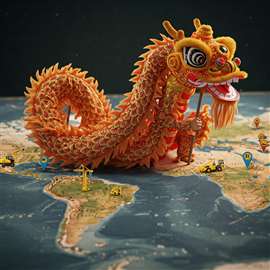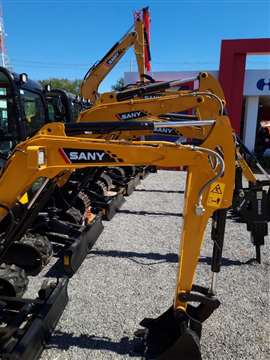The way of the dragons: Chinese construction OEMs chase overseas growth
16 May 2025
Stuttering domestic economic growth and increasing trade barriers are prompting Chinese construction equipment manufacturers to pursue ambitious global growth strategies. Andy Brown and Lucy Barnard assess the growth plans of Sany, XCMG, Zoomlion and Lovol - and ask how rental firms can benefit.
 Image created using AI via Gemini
Image created using AI via Gemini
Chinese construction equipment manufacturers are looking to partner with rental companies and brokers around the world as they pursue ambitious “chu hai” strategies.
A faltering domestic economy, attempts to circumvent US and European trade tariffs and infrastructure improvements created through the Chinese state’s Belt & Road initiative, are encouraging more Chinese manufacturers to look to “Chu hai” - the Chinese phrase to describe “going global” for expansion.
Although for much of the 1990s and 2000s, China’s fast-growing economy and cheap workforce was largely enough to sustain rapidly expanding firms such as XCMG, Sany, Zoomlion and Liugong, since the global pandemic, comparatively slow economic growth has encouraged more manufacturers to take up the “chu hai” rallying cry.
Chu Hai
And, despite restrictive trade barriers and growing geopolitical tensions, manufacturers say they are confident that technological innovations and strategic partnerships with local brokers and rental companies will give them the edge they need to grow foreign sales.
In February Chinese OEM, Sany Heavy Industry filed an intention to raise up to US$1.5 billion in a proposed initial public offering (IPO) on the Hong Kong stock exchange to support its global expansion efforts as international sales continue to outpace demand in China.
 Foto: KHL // CLA
Foto: KHL // CLA
Sany Group vice-president Jiang Qingbin told the South China Morning Post that the goal was to double overseas revenue from $7bn to $14bn by 2028, with a strong emphasis on working with local dealers and rental companies.
Overseas sales are currently increasing by 12% a year, and make up about 65% of Sany’s total.
“After the IPO, we will continue to promote globalisation, but globalisation is not about building factories. It’s mainly about people – building localised marketing channels is probably the most important thing,” Jiang said.
Many Chinese manufacturers would prefer to target developed markets of Europe and the USA where they can shift more higher spec machines and rely on existing infrastructure including dealer networks and established rental buyers.
XCMG, which is partly owned by the Chinese government and has operations in the USA, Germany, the Netherlands, Poland, Austria, Brazil, India and Uzbekistan, says it is accelerating its European expansion.
“XCMG, in the European market, at the very beginning, nobody knew us. But gradually the customers know this brand and they now trust us, accept this brand,” Yang Dongsheng, chairman of XCMG, told Rental Briefing’s sister title Construction Briefing. “Our purpose is to put our roots in the European market and grow here.”
XCMG’s chairman Yang Dongsheng said the company had benefitted from local partnerships with companies overseas as it attempted to familiarise itself with local markets.
“In the future, we are also interested to look for partners like rental companies and service providers to co-operate with,” he said.
One of the reasons for emphasising European growth is the introduction of steep US trade tariffs on Chinese goods which XCMG says have already delayed the company’s target of deriving 55% of its revenues from international sales by 2025.
Tariff deal
Although last week the US and China last week reached a temporary deal where US tariffs on Chinese goods currently stands at 30% and tit-for-tat Chinese tariffs on US imports stand at 10%, these still represent a hefty overhead for businesses.
“Actually it [55%] was the target for this year. But this year the international situation – lots of tariff and competition in different regions – means there are lots of uncertainties with the global business. And so, we will reconsider this very carefully.”
And Dongsheng said XCMG is also launching its own European financial leasing company to support rental customers and end users, making the OEM the first Chinese manufacturer to provide direct financing services in the European market.
 Yang Dongsheng, CEO and chairman of XCMG, gives a thumbs-up after a press event photo-op (Image: Mitchell Keller)
Yang Dongsheng, CEO and chairman of XCMG, gives a thumbs-up after a press event photo-op (Image: Mitchell Keller)
Yet, although many Chinese OEMs still see little value in shifting manufacturing operations outside of China, preferring to benefit from historically low wage costs and robust supply chains, some manufacturers are starting to set up their own manufacturing hubs overseas too.
The main reason for this change has been the recent introduction by both the USA and the European Union on some goods made in China.
Since the first Trump presidency, Chinese OEMs have set up a series of overseas factories in order to avoid the charges.
Of Zoomlion’s eleven research and development and manufacturing bases outside China, seven are in Europe, including: a new €100 million mobile elevated work platform (MEWP) manufacturing facility in Hungary; concrete pump and mixer manufacturer CIFA in Italy; dry-mixed mortar equipment manufacturer M-TEC, Wilbert TowerCranes, and Rabe, all three of which are in Germany; plus sites in Belarus and Turkey.
The company announced that it was building the new Hungary facility this spring, shortly after the European Union announced that Zoomlion was one a number of Chinese MEWP manufacturers whose machines would accrue additional tariffs when imported into the bloc.
Localised overseas strategies
“We are pursuing an ‘end-to-end, digital, localised’ overseas strategy, directly connecting with clients and markets through an efficient sales structure. This will ensure long-term, sustainable growth,” says said Zoomlion’s co-president Luo Kai.
Souring political relations between the Chinese and Western governments and recent infrastructure upgrades are also encouraging more Chinese construction equipment OEMs to target the global South for sales growth.
Sany currently has production facilities in the US, Europe, India and Germany. Earlier this year the company inaugurated a 90-acre manufacturing facility in Pune, India as part of a major expansion in the country.
Sany’s Jiang said that the manufacturer was already targeting the global South for expansion long before US trade tariffs came in.
 A digital render of Zoomlion’s new factory in Hungary, which will produce MEWPs for the European market (Image courtesy of Zoomlion)
A digital render of Zoomlion’s new factory in Hungary, which will produce MEWPs for the European market (Image courtesy of Zoomlion)
“Markets outside the US happen to be our focus, particularly the developing and emerging economies,” Jiang said. “We see higher demand from those regions, and there’s a relatively high acceptance of Chinese brands.”
Similarly, Zoomlion says it is shooting for further growth in its main international markets in the global south, in addition to Europe and North America.
“Our main markets are in Russian-speaking regions, Southeast Asia, and the broader Asia-Pacific. South America is also growing rapidly,” said Zoomlion’s co-president Luo Kai.
Some Chinese OEMs too are hoping to be able to reap the benefits of recent Chinese state infrastructure investment.
Over the past decade China’s Belt & Road initiative has channelled more than US$1 trillion of investment into power networks, railways and ports across the global south. Those investments are making it easier and more attractive to set up manufacturing hubs in the countries which have benefitted.
Wang Bin, managing director of Lovol Heavy Industry, said that his company’s sales are currently divided equally between Chinese and international markets but that he expects international sales to expand further in the future.
“Lovol’s export markets span across numerous countries and regions globally, among which countries along the Belt and Road Initiative’, Southeast Asia, Africa, and South America are important export markets,” he said.
Bin said the company was laying out global distribution channels, accelerating overseas market development, and expanding market coverage and service and accessories capabilities.
“We will strengthen our overseas team building to support global business and establish our advantage as a regional centre company, progressively expanding into the global market,” he said.
STAY CONNECTED



Receive the information you need when you need it through our world-leading magazines, newsletters and daily briefings.
CONNECT WITH THE TEAM










